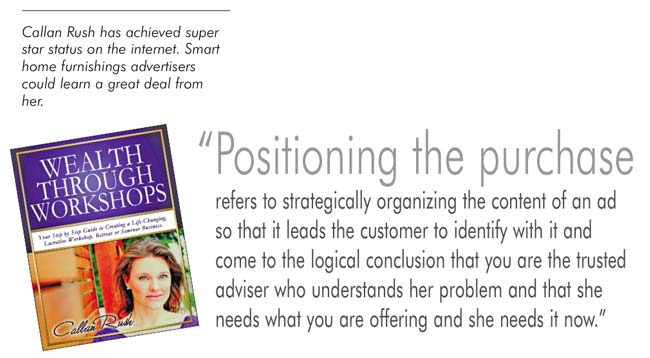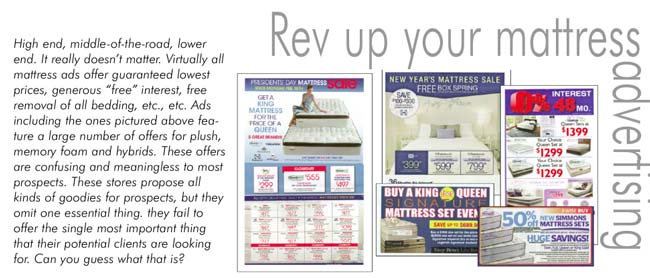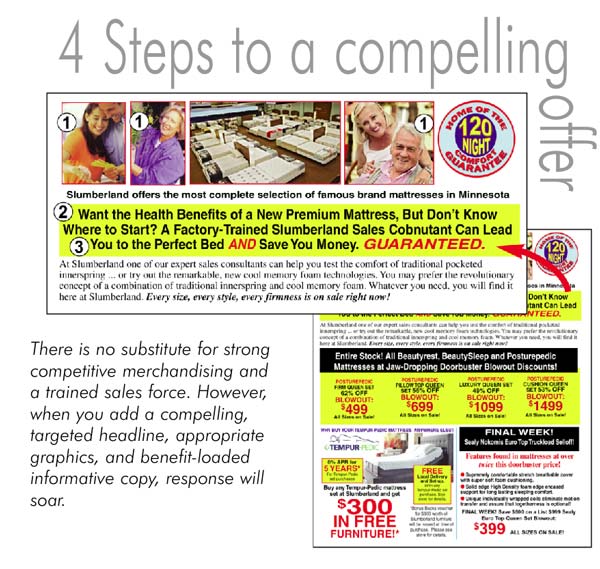The big hitters are spending a larger percentage of their budgets on advertising than ever before, and getting less and less return. Why? Because these home furnishings experts are in a ferocious fight for the 3% of the market that is ready to buy. That market is composed of people who are actively shopping for furniture and mattress sets. Most ad people know this as the “red ocean” of prospects. A very small niche of the market is responsive to advertising, ready to buy and an easy sell, so it’s under constant siege by furniture and mattress retailers, especially the Big Boxes.
This 3% also represents the segment of prospects, dominantly women, who noticed their furniture was showing wear four or five years ago. These ladies are not waiting any longer to get a fresh look going in their living rooms. This segment is also composed of people who know they need a new mattress, and they are sick and tired of dealing every morning with chronic back pain. The stories go on and on, they vary, but the bottom line is these folks mean business; they are ready to buy.
The downside of this statistic is inescapable: “97% of your ideal potential customers are NOT looking for your product.” Can this be true? Yes, the vast majority of the people who need your help to solve their home furnishings necessities are not looking for you or for your competitors.) This is true even though you have a good selection and a service-minded staff that could help them with the perfect solutions to their problems. These prospective customers are a tougher sell, yet they represent a huge blue ocean of potential sales and profit. Let’s briefly examine the 97% segment, and break it down to see how you can reach them.

Just beyond the 3% actively shopping, there are folks representing about 7% of the market, who are not quite ready to buy. Even so, they may like your store and they are at least open to a persuasive, “buy now” message. These 7% prospects have a problem to solve, and they know it. If we drill down further, there is a much larger, third category of potential customers. These are the 30% of buyers who are aware that they have a problem to solve, yet they have consciously decided to put off the purchase. Possibly when that promotion at work comes through they will be ready to buy. Or perhaps they will become active shoppers when their cash flow improves. Or maybe they want to wait until after they get the car paid off. They want a solution, but they believe the timing isn’t right.
The next 30% of your ideal clients are simply unaware. They just are not mindful that you could help them resolve their problems. Other issues have priority and dominate their concerns anyway. They are not actively shopping for furniture or mattress sets. And finally, there is a 30% segment of the general public who are just not interested. They are not persuadable. At least, they are not persuadable at this time.
Where Did These Statistics Come From?
Good question. A woman who became a multi-millionaire as a result of her work on the internet provided these numbers. Her name is Callan Rush. I find it fascinating that it is the internet marketing experts who are more tuned into attracting clients by focusing on solving their problems.
Rush recently wrote a book titled: “Wealth Through Workshops” in which she explained her marketing theories. Retailers who are price-item focused could learn a great deal from Rush. She is one of several female entrepreneurs who have capitalized on their nurturing, service-oriented natures and have made personal fortunes on the internet.
There are also fortunes to be made in retail home furnishings by the entrepreneurs who understand how to leverage their offers to dramatically increase market share. The purpose of this article is twofold.
- To clearly demonstrate to you why most furniture and mattress advertising is not working today and what you can do to fix yours.
- How, for the same amount of money you are spending now (or less,) you can begin to turbo-charge your offers and stand out above the crowd in the price-item circus.
The Price-Item Circus
There are no secrets in advertising. There is, however, a huge, neglected reservoir of long-standing principles that have been tested and retested and consistently proven to be effective. These principles are as valid today as they ever were. Good ads stand out in the wasteland of glitzy, but hastily produced, content-starved home furnishings ads. The Big Boxes copy each other and the independents follow suit. Rather than copying other stores, wise furniture and mattress entrepreneurs would be better off to heed that advice of Mark Cuban, of “Shark Tank” fame:
“Wherever I see people doing something the way it’s always been done, the way it's ‘supposed’ to be done, following the same old trends, well, that’s just a big red flag to me to go look somewhere else.”
Callan Rush states in her book that the #1 reason most businesses fail is that they are trying to fight it out in a bloody ocean battle for 3% of active shoppers. Very few furniture and mattress retailers know the secrets of how to access the neglected 67% of their ideal clients who have a home furnishings problem to solve. And yet, all that these prospects need is just a little education to become aware that your organization is essential to improving their lives. Follow me through this article and I will show you a simple “secret sauce” formula to help.

How To Make An Irresistible Bedding Offer
Let’s begin with bedding. In my judgment, mattress advertising has never been so inadequate and weak. The only reason mattress specialty stores spring up everywhere is because full line home furnishings stores do such a poor job of promoting the product. When you examine all the bedding offers, there is little to distinguish them. Virtually all mattress ads offer guaranteed lowest prices, generous “free” interest, free removal of old bedding, etc., etc. The ads of leading stores feature a large number of offers for plush, memory foam, and hybrid mattress sets that are confusing and meaningless to most prospects. These stores propose everything to prospects but one essential thing: They fail to offer what their potential clients are looking for.
Surprise. A mattress is a “sack of sand.” Prospects are not looking for the largest discount on an item they have no knowledge about and no way to evaluate. These potential clients are looking for someone they can trust. They are baffled by a huge selection of mattresses. What they need is a trusted advisor who will guide them to the perfect bed for their needs and budget. Collect all the mattress ads you can for a week or so… all the ROP ads, all the flyers. Watch all the TV spots on mattresses carefully. It is highly unlikely you will see a mattress ad that is properly positioned and also addresses the prospect’s most important concern.
No matter how great your offer is, it must be properly positioned. And, it must address the concerns of the targeted prospect (see exhibit above). This is the trickiest part of creating a compelling offer. Positioning is an art. Callan Rush describes it this way: “Positioning the purchase refers to strategically organizing the content of an ad so that it leads the customer to identify with it and come to the logical conclusion that you are the trusted adviser who understands her problem and that she needs what you are offering and she needs it now.” Once you master this very difficult art, everything else becomes easy.

Four Steps To A Compelling Offer
1. First define your target audience. Consider the illustrations you are using. Who is most likely to be interested in a new mattress? Most bedding ads are made by creators who seem to assume the store’s prospective customers are always gorgeous, vibrant young women. This is half true at best. Consider the older lady or gentleman who wakes up every morning with a backache because their mattress is worn out. See the exhibit for a few creative solutions to targeting your ad more effectively.
2. Consider and articulate the deepest concerns of your prospects. They may not be able to put their concerns into words. But if you can define their needs, you will have gone a long way towards winning them over. Check the exhibit above to see an effective appeal that will resonate with almost any bedding prospect: “Want all the health benefits of a new mattress but don’t know where to start?”
3. Offer a solution to address their concerns: “One of our factory-trained experts will guide you to the perfect bed for your body, GUARANTEED.” Obviously you must deliver on your promise when they visit the store. Assuming you are able to do so, you will have attained the precious role of trusted advisor, and you will have acquired a valuable lifetime client.
4. Instruct your sales consultants in how to sell the ultimate dream. Most sales people are trained to understand the key principle of a sales presentation: “Never point out a product feature without explaining the benefit it provides.” For example: “This premium mattress features 550 pocketed coil springs to cradle you in perfect comfort.” Master sales consultants go further. They know the added value of benefits can accumulate to support the ultimate dream of better, more effervescent health: “When you sleep better the health benefits can be a game-changer for improving your life.”
During a time when home furnishings have never been a greater value, furniture and mattress advertising has never been so ineffective and wasteful. And herein lies the opportunity for the independent furniture entrepreneur to recapture market share by adopting Evidence-Based Advertising.
The original theory was: Just run more advertising than anyone else, and overwhelm the market with a geyser of print and TV. Expensive, but it did work for a while, especially when the use of slick color flyers was a relatively new idea. But, newspapers are now cluttered with look-alike flyers and the playing field has leveled. Moreover, the recession-burned customer is tougher and more suspicious. So the big box tsunami of TV and print is now draining more and more cash while producing less and less result.
It is time for independent home furnishings entrepreneurs to review the proven, Evidence-Based principles about advertising and put them to work. Resolve to start creating messages that are content-rich, and communicate empathy for a prospect’s concerns. While your competitors are still frozen like a deer in the headlights, get ahead of the curve with Evidence-Based furniture advertising. Tested advertising principles will put you well ahead of all your competitors.
More information on Evidence-Based advertising principles and “Blue Ocean” philosophy, can be found by clicking on “View all articles by Larry Mullins” on the furninfo.com website at:
https://www.furninfo.com/Authors/List
Larry Mullins is a contributing editor for Furniture World and has 30+ years of experience on the front lines of furniture marketing. Larry’s mainstream executive experience, his creative work with promotion specialists, and mastery of advertising principles have established him as one of the foremost experts in furniture marketing. His affordable High-Impact programs produce legendary results for everything from cash raising events to profitable exit strategies. His newest books, THE METAVALUES BREAKTHROUGH and IMMATURE PEOPLE WITH POWER… How to Handle Them have recently been released by Morgan James Publishing. Joe Girard, “The World’s Greatest Salesman” said of this book: “If I had read Larry Mullins’ book when I started out, I would have reached the top much sooner than I did.” Larry is founder and CEO of UltraSales, Inc. and can be reached directly at 904.794.9212 or at Larrym@furninfo.com. See more articles by Larry at www.furninfo.com or www.ultrasales.com.